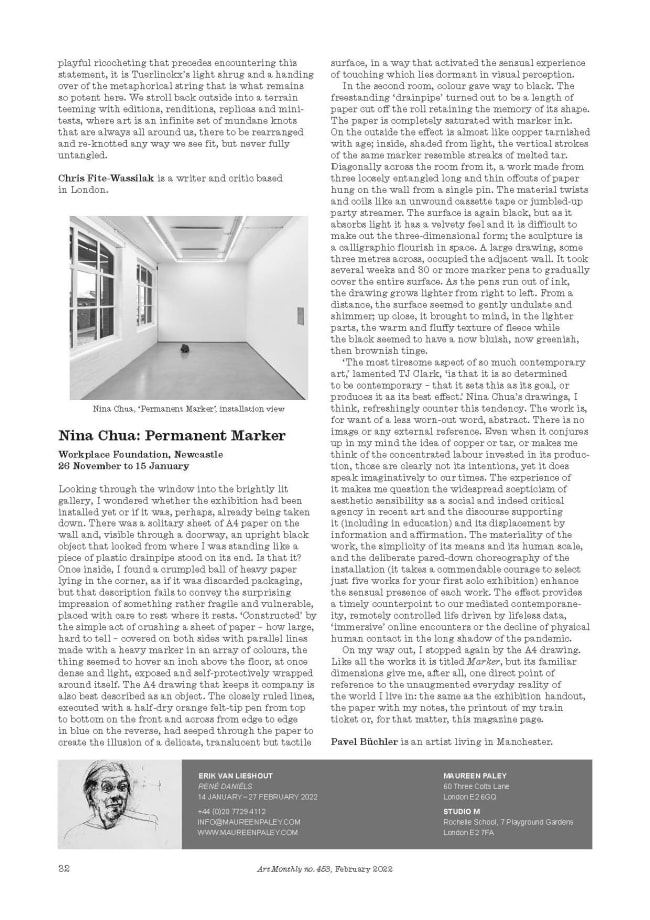Nina Chua: Permanent Marker
Workplace Foundation, Newcastle
26 November to 15 January
Looking through the window into the brightly lit gallery, I wondered whether the exhibition had been installed yet or if it was, perhaps, already being taken down. There was a solitary sheet of A4 paper on the wall and, visible through a doorway, an upright black object that looked from where I was standing like a piece of plastic drainpipe stood on its end. Is that it? Once inside, I found a crumpled ball of heavy paper lying in the corner, as if it was discarded packaging, but that description fails to convey the surprising impression of something rather fragile and vulnerable, placed with care to rest where it rests. ‘Constructed’ by the simple act of crushing a sheet of paper – how large, hard to tell – covered on both sides with parallel lines made with a heavy marker in an array of colours, the thing seemed to hover an inch above the floor, at once dense and light, exposed and self-protectively wrapped around itself. The A4 drawing that keeps it company is also best described as an object. The closely ruled lines, executed with a half-dry orange felt-tip pen from top to bottom on the front and across from edge to edge in blue on the reverse, had seeped through the paper to create the illusion of a delicate, translucent but tactile surface, in a way that activated the sensual experience of touching which lies dormant in visual perception.
In the second room, colour gave way to black. The freestanding ‘drainpipe’ turned out to be a length of paper cut off the roll retaining the memory of its shape. The paper is completely saturated with marker ink. On the outside the effect is almost like copper tarnished with age; inside, shaded from light, the vertical strokes of the same marker resemble streaks of melted tar. Diagonally across the room from it, a work made from three loosely entangled long and thin offcuts of paper hung on the wall from a single pin. The material twists and coils like an unwound cassette tape or jumbled-up party streamer. The surface is again black, but as it absorbs light it has a velvety feel and it is difficult to make out the three-dimensional form; the sculpture is a calligraphic flourish in space. A large drawing, some three metres across, occupied the adjacent wall. It took several weeks and 30 or more marker pens to gradually cover the entire surface. As the pens run out of ink, the drawing grows lighter from right to left. From a distance, the surface seemed to gently undulate and shimmer; up close, it brought to mind, in the lighter parts, the warm and fluffy texture of fleece while the black seemed to have a now bluish, now greenish, then brownish tinge.
‘The most tiresome aspect of so much contemporary art,’ lamented TJ Clark, ‘is that it is so determined to be contemporary – that it sets this as its goal, or produces it as its best effect.’ Nina Chua’s drawings, I think, refreshingly counter this tendency. The work is, for want of a less worn-out word, abstract. There is no image or any external reference. Even when it conjures up in my mind the idea of copper or tar, or makes me think of the concentrated labour invested in its production, those are clearly not its intentions, yet it does speak imaginatively to our times. The experience of it makes me question the widespread scepticism of aesthetic sensibility as a social and indeed critical agency in recent art and the discourse supporting it (including in education) and its displacement by information and affirmation. The materiality of the work, the simplicity of its means and its human scale, and the deliberate pared-down choreography of the installation (it takes a commendable courage to select just five works for your first solo exhibition) enhance the sensual presence of each work. The effect provides a timely counterpoint to our mediated contemporaneity, remotely controlled life driven by lifeless data, ‘immersive’ online encounters or the decline of physical human contact in the long shadow of the pandemic. On my way out, I stopped again by the A4 drawing. Like all the works it is titled Marker, but its familiar dimensions give me, after all, one direct point of reference to the unaugmented everyday reality of the world I live in: the same as the exhibition handout, the paper with my notes, the printout of my train ticket or, for that matter, this magazine page.
Pavel Büchler is an artist living in Manchester.


